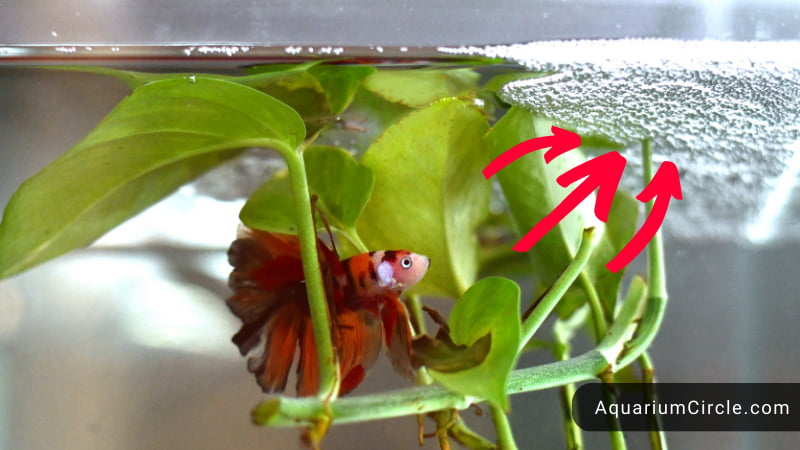Have you ever seen a group of bubbles clustered together on the surface of your betta fish’s tank and wondered what it was? Well, it turns out that your male betta fish may have been busy creating a betta bubble nest! While it may seem like a simple and innocuous behavior, bubble nest construction is actually an important aspect of betta fish reproduction. However, as a pet owner, you may be wondering what exactly this behavior means and whether you should be concerned or involved in any way.
In this article, we will dive into the world of betta bubble nest, discussing their purpose, how they are created, and what you should do to care for them. Whether you are a new betta owner or have been keeping these fish for years, understanding this fascinating aspect of betta biology can help you give your betta happy and healthy liives, as well as appreciate their unique personalities.
See also
- Healthy Betta Fish Vs Unhealthy: 9 Signs You Must Notice Before Your Pet Dies
- How Many Betta Fish In A 10 Gallon Tank: Useful Guide
- Why Betta Fish Staying At Top Of Tank & The Best Solutions For It
What Is A Bubble Nest?
A bubble nest is a series of bubbles that are created by betta fish and float on the surface of the water. These bubble nests come in various shapes, sizes, and forms, with some resembling foam patches, while others have a distinctive bubble-like shape with ample air trapped inside.
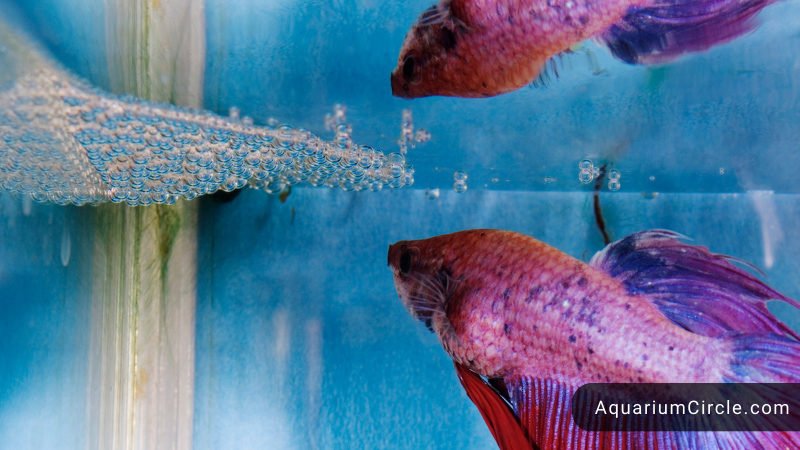
Typically, it is male betta fish who are the primary architects of bubble nests. These nests play a vital role in their mating ritual, as they use them to prove to a potential mate that they are capable of providing adequate care for their offspring. However, it is not unheard of for female bettas to help with the construction of the nest if they are particularly keen on the male in question.
The male fish will often wait beneath the bubble nest, hoping to attract a female fish who will be enticed by the nest and his impressive building skills. Once mating occurs, the male betta will carefully move the eggs to the nest and diligently protect them for several days or even weeks until the baby bettas are mature enough to live independently.
It is fascinating to witness this intricate dance between male and female bettas, where bubble nests play an essential role in ensuring successful mating and subsequent offspring survival. Overall, bubble nests are a unique aspect of betta fish behavior that showcases their intelligence, creativity, and innate drive to reproduce and care for their young.
Why Do Betta Fish Make Bubble Nests?
Bubble nests are an interesting and complex phenomenon in the world of betta fish. These nests, created by the male betta fish, serve as an integral component of the species’ mating process. When preparing to mate, male bettas use bubble nests as one of their primary selling points to attract a potential female partner, in addition to their strikingly bright and vibrant colors.
While bubble nests may appear simple to the human eye, male bettas put significant time and effort into constructing an aesthetically pleasing and attractive nest. Nevertheless, female bettas may take an interest in the male and lend a helping fin in the nest-building process.
Beyond their role in the mating process, bubble nests offer a safe haven for betta eggs and young hatchlings, also known as fry. The bubbles created by the nest provide ample oxygen for the young to thrive, allowing males to protect a designated territory from potential predators.
Additionally, betta fish may build bubble nests in response to sudden changes in their tank’s water parameters. Originating from Thailand, where changes in rain patterns can trigger betta fish to build nests, the species may also build nests in response to rapid temperature changes.
While some betta owners may believe that bubble nest building signs that your fish is happy, there is no scientific evidence to support this notion. Instead, the behavior appears to be primarily driven by instinct.
Overall, the creation of bubble nests by male betta fish is a fascinating and integral aspect of their biology, serving as a critical component in the species’ mating ritual and offspring survival.
How Important Is Betta Fish Making A Bubble Nest?
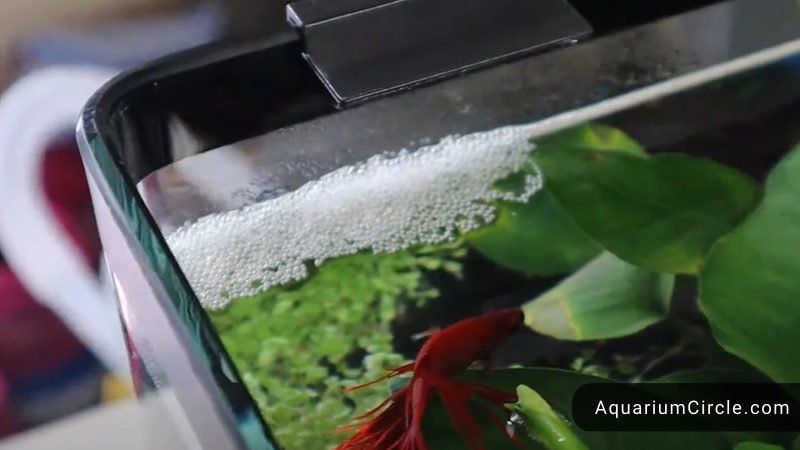
Betta fish bubble nests are significant for the species’ mating and survival process. While betta making bubble nest is not always present in every betta fish, it is an instinctual behavior that occurs in many male bettas. Males construct the nests by using their mouths to blow bubbles, creating a structure that is then used to entice females to lay eggs.
When females lay eggs in the bubble nest, males will then fertilize them and guard the nest from predators. The nest’s bubbles help to keep the eggs and newly hatched fry afloat and provide the young with the necessary oxygen for survival. As such, the presence of a bubble nest indicates that your male betta fish is actively seeking a mate and is in a breeding condition.
While it may be aesthetically pleasing to have a bubble nest in your fish tank, it is not necessary for the betta fish’s health or well-being. Some male bettas may not build bubble nests, but this does not indicate that they are unhealthy or unhappy.
It is also important to note that bubble nests should not be used as a sole indicator of a betta fish’s health or happiness. Many factors contribute to a betta fish’s well-being, including water quality, tank size, temperature, and diet.
Betta Bubble Nest Making Process
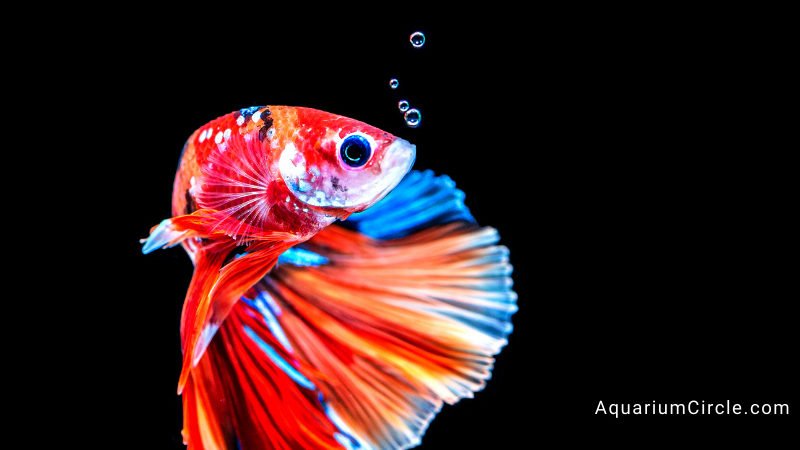
Betta fish bubble nests are fascinating structures that male bettas create when they are ready to mate. This process typically occurs during the warmer months, as betta fish are most active in their breeding season.
The male betta begins the nest-building process by creating a few bubbles in his mouth, then spitting them out onto the water’s surface. He will use his mouth to gather and arrange the bubbles into a circular shape to form the nest. The nest’s appearance may vary depending on the individual male betta’s preference. Some bubble nests may appear as a patch of foam, while others may look like a series of bubbles in a distinct pattern.
Once the male betta completes the nest, he will swim beneath it, waiting for a female betta to notice him and the nest. The bubble nest is a crucial tool for attracting a mate, as it shows that the male is capable of protecting and caring for the young. The male betta will guard the nest against predators and use the bubbles to keep the eggs afloat and provide oxygen for the newly hatched fry.
When a female betta becomes attracted to the male and the nest, she will lay her eggs in the nest, and the male betta will fertilize them. The bubbles from the nest help to keep the eggs afloat, allowing for the proper development of the embryo. The male betta will guard the nest for several days until the eggs hatch, and the fry/ baby betta fish become independent.
It is important to note that not all male bettas will create bubble nests, as this behavior depends on factors such as age, genetics, and environmental conditions. Additionally, females may also help with nest building in some cases, although this is less common.
Environmental Factors That Affect Bubble Nest Building
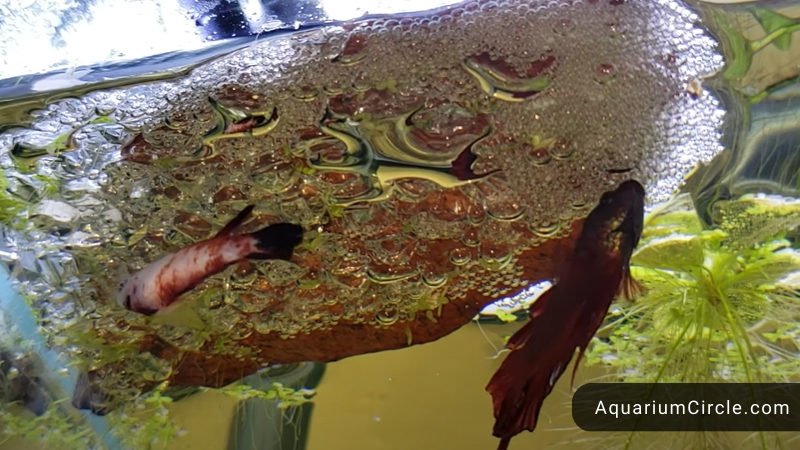
Bubble nest building is a natural and instinctive behavior that betta fish exhibit when they are ready to mate. However, several environmental factors can influence a male betta’s decision to build a bubble nest. Here are some of the most critical environmental factors that can affect bubble nest building in betta fish:
- Temperature: Temperature is one of the most important environmental factors that affect betta fish’s behavior, including bubble nest building. Betta fish are tropical fish and prefer water temperatures between 76 and 82 degrees Fahrenheit. When the water temperature drops below 76 degrees Fahrenheit, betta fish may become sluggish, lose their appetite, and stop building bubble nests. On the other hand, when the water temperature is too high, the male betta may build a bubble nest, but the bubbles may not be as sturdy as they would be at optimal temperatures.
- Water Quality: Water quality is another crucial factor that can affect betta bubble nest building. Betta fish are sensitive to water quality and can become stressed if the water is not clean and healthy. Poor water quality can also weaken the bubbles in the nest, making them less effective at keeping the eggs afloat. Therefore, it is crucial to maintain the proper water parameters, including pH, ammonia, nitrite, and nitrate levels, to ensure optimal water quality.
- Lighting: Lighting can also affect bubble nest building in betta fish. Betta fish prefer dimly lit environments and may become stressed or agitated if the fish tank is too bright. Too much light can also cause algae growth, which can damage the bubble nest and make it less effective at keeping the eggs afloat.
- Tank Size: The size of the tank can also affect bubble nest building in betta fish. Male bettas require enough space to swim and move around to build a nest effectively. If the fish tank is too small, the male betta may not have enough space to construct a sturdy nest. Therefore, it is essential to provide adequate space for your betta fish to thrive and build a bubble nest if they choose to do so.
How To Maintain And Care For Betta Fish Bubble Nest
Betta fish bubble nests are fragile and require proper care to ensure the safety and health of the eggs and fry. Here are some tips to maintain and care for your betta fish bubble nest:
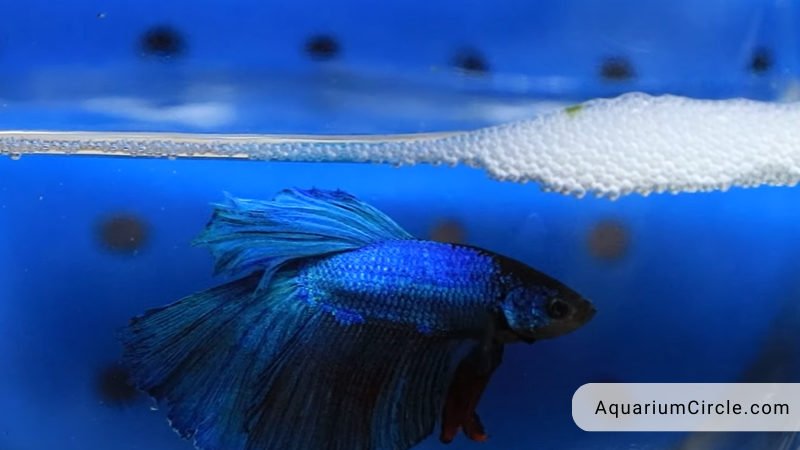
Keeping the water clean is crucial to maintain a healthy environment for the eggs and fry. A dirty tank can cause bacterial infections that can be fatal for the eggs and fry. It is essential to clean the tank regularly and perform partial water changes at least once a week to maintain good water quality.
Strong currents can destroy the bubble nest, so it is essential to avoid them. Bettas create bubble nests on the water surface, and the current created by filters or air stones can damage the nest. Place the filter in a way that it creates a gentle flow of water, or use a sponge filter that has a low flow rate.
Maintaining the right temperature is crucial for the health of the eggs and fry. Bettas prefer warm water with a temperature range between 78-82°F (25.5-28°C). Use a heater to maintain the right temperature, and avoid fluctuations as they can negatively affect the bubble nest and the eggs.
Disturbing the bubble nest can cause the male betta to abandon the nest or become stressed. Bettas are sensitive to movement and noise, so it is essential to avoid tapping the glass, sudden loud noises, or touching the nest.
Providing hiding places is crucial for the fry once they hatch. Fry need a place to hide and rest, and adding live plants, decorations, or breeding cones to the tank can provide hiding places for them.
Removing unfertilized eggs is essential as they can cause bacterial infections that can be fatal for the eggs and fry. After mating, some eggs may remain unfertilized and start to rot. You can remove the unfertilized eggs from the nest with a turkey baster or a pipette.
Monitoring the betta’s behavior is crucial to ensure that they are taking care of the bubble nest and the fry. If the male betta appears to be neglecting the nest or the fry, it may be necessary to remove him from the tank. Monitoring the fry for any signs of illness, and providing them with a suitable diet is also essential.
See also: Betta Fish Water Temperature: What Is The Ideal Range Of Betta Fish Water Temp?
How To Encourage Your Betta To Build Bubble Nests
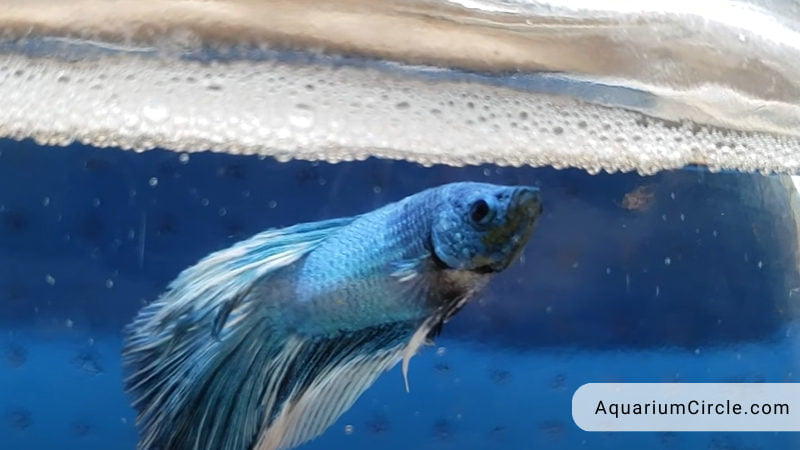
Betta fish build bubble nests naturally, but there are a few things you can do to encourage your betta to build a nest in your aquarium. Here are some tips:
- Provide the Right Environment: Bettas need a clean and comfortable environment to thrive. Ensure that the water in the tank is free of chlorine, ammonia, and other harmful chemicals. Bettas prefer warm water, so maintain a temperature of 78-80°F (25-27°C) in the tank.
- Give Your Betta Space: Bettas need space to swim and explore. If your tank is too small, your betta may become stressed and less likely to build a nest. A good rule of thumb is to provide at least 5 gallons of water per betta.
- Add Plants and Decorations: Bettas are naturally curious fish, and they enjoy exploring their surroundings. Adding floating plants and decorations to your tank will give your betta plenty of places to hide, rest, and build a nest. Live plants also provide additional oxygen, which can encourage bubble nest building.
- Keep the Water Calm: Bettas build bubble nests in calm waters, so avoid using a filter or air stone that creates a lot of water movement. A gentle filter or sponge filter is ideal for a betta tank.
- Offer High-Quality Food: A healthy betta is more likely to build a bubble nest. Offer your betta a varied diet of high-quality pellets, frozen or live foods, and treats. Avoid overfeeding, as excess food can pollute the water and make your betta sick.
- Introduce a Female Betta: If you want to breed bettas, introducing a female to your male betta may encourage him to build a bubble nest. However, breeding bettas requires careful planning and preparation, so research the process thoroughly before attempting it.
By following these tips, you can create a comfortable and stimulating environment for your betta, which may encourage them to build a beautiful bubble nest. Remember to monitor the water quality, maintain a stable temperature, and provide your betta with a varied diet to keep them healthy and happy.
See also: Why My Betta Fish Won’t Eat? 11 Reasons In Depth That Have Immediate Solutions
What To Do If Your Male Betta Is Not Making Bubble Nest?
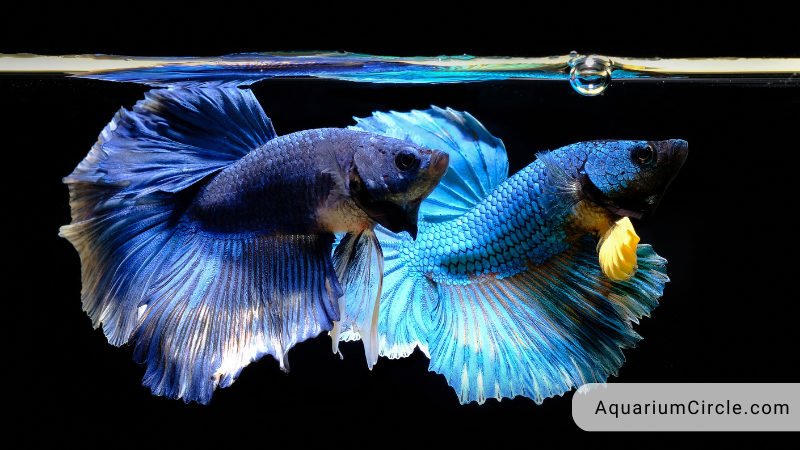
If your male betta is not making a bubble nest, it may indicate a few different issues that need to be addressed. Here are some things you can do:
- Check water conditions: Bettas are sensitive to changes in water conditions, and poor water quality can lead to stress and health problems that may affect bubble nest building. Make sure your tank water is clean, cycled, and within appropriate temperature and pH ranges.
- Increase humidity: Bettas build bubble nests to protect their eggs and fry, and high humidity levels can encourage bubble nest building. You can increase humidity by adding a lid to your tank or placing a damp towel over the top.
- Add live plants: Bettas often build bubble nests around live floating plants, and having plants in your tank can also provide a natural and calming environment. Some good plant options include java moss, anubias, and java fern.
- Provide hiding places: Bettas may not build bubble nests if they feel stressed or threatened, so it’s important to provide plenty of hiding places in the tank. You can add plants, caves, or other decorations that allow your betta to retreat when needed.
- Give it time: It’s also possible that your betta is simply not ready to build a nest yet. Males typically build bubble nests when they’re ready to mate, and it may take some time for your betta to reach this stage. Be patient and continue to provide a healthy and stimulating environment for your fish.
If your betta continues to show no interest in building a bubble nest, it’s important to monitor its behavior and health closely. Lack of bubble nest building can be a sign of stress or illness, and you may need to take further steps to address any underlying issues.
Video About Betta Bubble Nest
FAQs
Do female bettas make bubble nests?
No, female betta fish do not make bubble nests. Bubble nest building is a behavior exhibited by male betta fish as part of their mating ritual.
Should I remove betta bubble nest?
It is not recommended to remove a betta bubble nest as it serves as a vital part of the breeding process and removing it can cause stress to the male betta. However, if you need to perform maintenance in the tank, it is best to do so carefully around the nest to avoid disrupting it as much as possible.
Does a bubble nest mean my betta is happy?
Not necessarily. Bubble nest building is a natural behavior in male bettas and is primarily associated with mating and reproduction, rather than happiness or contentment. However, a healthy and well-cared-for betta is more likely to engage in bubble nest building behavior.
References

Annette M. Chaney is an experienced marine biologist with over 20 years of experience as an aquarist and fishkeeper. She started her first aquarium at a young age, filling it with frogs and goldfish obtained from the ten-cent pet store.
Annette grew up caring for and breeding African Cichlids, which led to a hobby in high school that doubled as a profitable means. Attending Reed College gave her time to solidify herself as an accomplished aquarium caretaker with an eye for sales. After that, from 2009 – 2013, she studied at Roger Williams University – one of the most prestigious universities for Aquaculture and Aquarium in USA. She is the founder of AquariumCircle since 2010.
